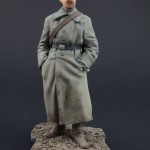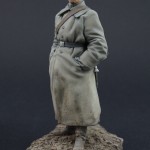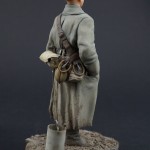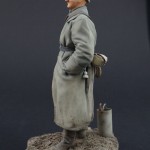



For more photos of this figure, see the FLAMGA Gunner 1915 figure page.
Bavarian MG08 Gunner ca. 1915
- Scale / Maßstab: 1:16
- Approx. height of figure: 114mm
- Material: Resin (figure), Model Plaster (base) / Resin (Fugur), Modell-Gips (Sockel – synethetische, kunststoffveredelte Gießmasse)
- Parts: See Below
- Infosheet / Infoblatt: English
- Code: 28MGF
Contents Figure / Inhalt Figur:
- Figure (3 parts) / Figur (3 Teile)
- Head with Spiked Helmet M1895 (3 parts) / Kopf – Lederhelm mit Spitze M1895 – Pickelhaube (3 Teile)
- 2nd Alternative Head with Prussian Shako Model 1895 (3 parts) / 2. Alternativ-Kopf mit Preußischen Tschako Modell 1895 (3 Teile)
- Canvas Gas Mask Holder / Segeltuchtasche für Gasmaske
- Haversack M1887 / Brotbeutel M1887
- Water Bottle M1907 / Feldflasche M1907
- Bayonet M1898/1905 / Seitengewehr M1898/1905
- Leather Case for ZF 12 Sight / Futteral zum ZF 12
- Metal Cup M1916 / Tasse M1916
- Leather MG Dragging Strap / MG-Schleppgurt (cast on body and haversack)
- Pistol 01 / Pistole 01 (or P01)
- Steam Condensing Can old type (3 parts) / Kühlwasserbehälter alter Art (3 Teile)
- Empty Ammunition Cases / Leere Patronenhülsen
- Figure Base / Figur-Sockel
Extracts from the Infosheet with this figure:
The first MG Detachments were formed in 1901 and by the outbreak of the war in 1914 a total of 11 independent Maschingewehr-Abteilungen were listed. Parallel to the MG Detachment, which were attached to Cavalry Divisions, new MG companies were formed within the Infantry Units, being traditionally the Regiment’s 13th Company. Some regiments formed a 14th company, which became the Fortress MG Company / Festungs MG-Kompanie.
The figure depicts a machine gunner attached to the 14th Bavarian Infantry Regiment, stationed in Nurnberg (German spelling Nürnberg). The original idea for this figure came from an early wartime group photo of this Unit during their stay in the barracks in Nurnberg.
The figure can be made up on the single base provided, with the MG condenser can positioned behind (or alternately displayed with the FLAMGA Kit with the MG08 mounted on a tree trunk in the anti-aircraft role. Both bases are designed to fit together).
Uniform
Spiked Helmet M1895 with Cover / Lederhelm mit Spitze M1895 mit Überzug: Popularly known both in English and German as a `Pickelhaube´. The correct name translated is `Leather Helmet with Spike´. This type of headwear dates back to 1842 and was made out of leather, with the spike, emblem and rim edges in brass. They gave no protection whatsoever during combat. On the front is the state emblem and each side where the chin- strap is attached are the two Kokarden. Right side – Reichskokarden: Imperial cockade. Left side Landeskokarden: State cockade. The chin- strap is on top the helmet cover. In the field these helmets were protected with a cotton cover.
Within the first few months of the static trench warfare, troops were removing the spikes and tucking the remaining excess cloth into the (ventilating) hole. From approx. mid 1915 helmet covers were issued without the spike material. With the figure the spike has been made separately, allowing the helmet to be shown, as it would have been in a front line area at the beginning of 1915. The cover has 4 seams running from top centre of helmet to edge / bottom.
Prussian Line Regiments, (apart from Guards) applied unit numbers in red onto the front of helmet covers. Shortly after the out- brake of war a new directive (in Bavaria on 04.09.1914) stated that all numbers and the letters “R” for Reserve and “L” for Landwehr regiments were to be in a less conspicuous light green. Later, a green cloth was used. Colour: Cover – rush-green (in practice these covers would fade within a short time and the result was a light beige, or grey colour). Chin strap – The standard brown leather chinstrap with two adjustable brass buckles (later steel or matt grey painted steel) lies on top of the helmet cover.
Other Ranks Shako M1895 with Cover M1915 / Mannschafts-Tschako M1895 mit Überzug M1915: The standard shako for other ranks, generally associated with the German Light Infantry Regiments such as Jäger and Schützen, but also worn by Machine Gun Detachments (only in Prussia and Saxony Units), Telegraph – Signal, Air Service (including Airship) and Transport Units. Up until 1854 Jäger battalions had worn the Pickelhaube and it was not until the 1950s that the last shakos were being phased out in the West German Police Force. As the war progressed and particularly after 1916, fighting units were issued the steel helmet and shakos were seldom seen within the front line areas. The cover was worn on active service with the chin strap either behind or on top. The helmet cockade or field badge / Feldzeichnen made out of cloth covered wood was still affixed to the top of the shako during the first months of the war, but discouraged by many front line Units thereafter (officially stopped as per German Army Regulations / AKO 21.09.1915).
Made out of black painted leather with the seam running down the front behind the helmet plate badge. The helmet form tapered slightly towards the top and the rear and was shaped to the head. It had an oval leather top stitched to the body, with gloss black painted brass vents directly underneath, at the sides, each with 6 holes. The front and rear visors were made out of thick leather and had a black polished finish. The natural leather interior had a 9-finger liner tied in the middle with a cord. The shako cover has one seam running around the top and a second running from the field badge to end of front visor. In Prussia and Saxony the MG-detachments wore a grey-green shako cover and from 15.08.1914 the detachment No. was to be applied in green.
The standard brown leather chinstrap with two adjustable brass buckles (later steel or matt grey painted steel) lies on top of the helmet cover. The two strap attachments on each side were normally of the same material as the buckles.
Neck Band / Halsbinde M1914: Designed to soak up the sweat and at the same time keep the field service dress or overcoat collar clean. Between the overcoat collar and the neck on the figure one can make out the Neck Band M1914. This was the replacement to the M1907 Neck Cloth, a square piece of material, which produced problems when the wearer was marching, actually causing the garment to tighten up around the neck. The neck band on the other hand was smaller and not unlike a detachable shirt collar, with a semi-circle apron of material attached underneath. Colour: these neck bands varied in colour from grey, light- grey to grey- green.
Grey Overcoat for Mounted Troops M1904 / Mantel für Berittene M1904: The standardized field grey coat M1904 for mounted troops (in Bavaria M1909) and was also issued to the field artillery, train (supply) units and MG detachments. This other-ranks coat was longer than the standard M1894 for infantry and had the following differences:
- Incorporated in the back area there was a 7 cm fold in the centre, which was sawn together below the collar and ended at the waist
- The rear, bottom slit ended at 15 – 20 cm below the waist and was longer than the coat issued to foot troops (required when on horseback)
The removal of the shoulder straps was a step taken at the beginning of the war, but not with all units. In some cases and with the original photo, the straps were never fixed to the coats.
Colour: in 1915 the coats were of the same field grey as that of the infantry. The buttons were of Tombak (An alloy of copper and zinc, which had a matt bronze/yellow colour), or on pre-war coats brass.
Infantry Boots M1866 / Infanteristiefel M1866: The nailed infantry boots for other ranks were made out of leather and had a tendency to `winkle´ down around the ankles after being worn in. Depending on size they had between 35 and 45 nails in the sole and reinforced heel. On each side of the boot shaft are seams where the front and rear of the leather are joined together. Colour: at the beginning of the war the boots had a natural light tan, which was then often darkened by coats of dubbin. As per Army regulation September 1915, boots (and much of the other leather items as well) were issued in blackened leather.
Equipment
Belt M1895 / Koppel M1889: From late 1915 onwards, belts were issued blackened, with a grey buckle. Up until then most leather equipment was issued in brown. Within the first few months of the war, belt buckles were being painted over in grey.
Company Bayonet Knot / Kompanie-Troddel: These enabled the wearer’s company to be identified and were attached around the bayonet frog. Up until 1915/16 German infantry regiments wore the bayonet knot to distinguish the 12 companies within an infantry regiment. The MG Company at this time was traditionally 13th. The knots were phased out from mid-1916, the latter Troddel being produced from inferior quality cotton, with the base white colour appearing light grey or off-white. Surplus stocks were still being issued up until the end of the war. Colour: the knots of the 13th MG Company were white, apart from the blue stem between small & large bobble.
Under the bayonet knot tassel on the figure I have added a casting web to ease the production process – this requires removing.
MG08 Dragging Strap / Tragerriem zum MG 08 or MG-Bandelier: This is an early-model dragging strap with the simplified ring and hook attachments and was worn by MG crews throughout the war. These straps were principally used to drag the MG or ammo cases in the field and in some cases even in the prone position. Later the straps were manufactured from canvas due to the shortage of leather. Colour: strap – brown leather, outer metal ring – brown leather (covered steel), metal hook – steel.
The main part of the leather belt has been cast onto the figure; the rest is attached to the top of the haversack with one of the attachment rings. The other ring and both hooks should be added afterwards (these I have cast separately to enable the positioning of these items on top of the water bottle and haversack).
Leather Case for ZF12 / Lederköcher für Zielfernrohr ZF12: The leather holder for the ZF12 has been supplied as an extra and would normally be carried by the gunner. The Prismatic Optical Sight ZF12 was the standard sight for the wartime MG08s. Colour – brown leather.
Haversack M1914 / Brotbeutel M1914: Also known as the bread bag. Made out of a canvas material and generally used for rations etc. It was a popular place to keep the spare gas mask filter. The small leather fastening strap on middle left side is to fasten the water bottle, avoiding unnecessary movement. Colour: grey- brown or khaki canvas colour, buttons – zinc, small leather straps – brown.
Water Bottle / Feldflasche M1907: This had a capacity of 0.8 litres and was attached to the haversack/bread bag by means of a leather strap and buckle. Originally made from aluminium, later Ersatz material and covered with a brown felt material. On one side are the four metal snap fasteners, which were either left blank or painted over in grey. It was quite common for front line troops, particularly during combat periods to carry a second water bottle. The screw on top was in aluminium.
Metal Cup M1916 / Tasse M1916: The enamelled steel cup replaced the earlier aluminium version (production was discontinued in October 1914 due to lack of aluminium) and can be fixed to one of the bread bag fastening straps. The opposite end to the handle is a small indent in the rim to allow the cup to be used as a small jug. The official place for this cup was inside the bread bag. Colour: light olive green / field-grey.
I have seen various photos of this item being fixed to the bread bag fastening strap, above the water bottle – the handle may need to be cut open, depending on where it is fixed.
Canvas Gas Mask Holder / Segeltuchtasche für Gasmaske: In 1915 a canvas gas mask holder was issued with 2 dividing walls within, which stowed the mask, filter and reserve-filter in a metal tin. The holder was generally worn either attached to the belt below the rucksack at the rear, or on the right side / front by means of 2 belt loops made from the same material and fastened with zinc buttons. Later versions of the holder had ring attachments on each of the belt loops enabling the fixing to the bread bag. Although generally used in the early part of the war, late war photos still show troops issued with this holder. The No. 2 at one end of the holder is the gas mask size and this has been modelled slightly raised to enable easier painting. On the model, part of the flap has lifted to reveal one side of the metal tin containing the spare filter. Colour: canvas holder – light grey- brown, number – dark coloured stamp colour – could have been black (on the original items these numbers are quite faded), filter tin – grey-green.
Weapons / Accessories
Pistol 08 / P 08 or Luger (the Germans never called this weapon the Luger – this is an anglicised name): The P 08 was first produced in 1900, with the German military taken it on in 1908 – hence the Pistole 08. As a service pistol it had its drawbacks, mainly it was expensive, difficult to produce and susceptible to dirt. Experienced front line NCOs and men preferred the larger or chunkier pistols as opposed to smaller pistols used by officers. Colour of holster: blackened leather.
Bayonet M1898/1905 / Seitengewehr M1898/1905: This was the so called butcher bayonet, with the distinctive wide blade at the top, near the point. The handle had a wooden grip, with 9 carved angled notches on each side for better grip and the sheath was black. Just above the guard (were the blade starts) is the lubricating hole for the locking mechanism. The bayonet frog – Seitengewehrtasche – would have been natural brown leather, later in the war blackened.
Cylindrical Water Condenser 1st Model for MG08 / Wasserkessel (1. Modell zum MG 08): Named the water bucket / Wassereimer by the German MG crews and used to collect the condense steam generated by the sustained firing of the MG and to refill the cooling jacket afterwards. The steam hose end had to be submerged into at least ¼ of the can’s contents, otherwise the steam would vaporize. The spout could be locked in the upwards position by the handle or folded down and locked underneath when not in use. Today these cans are amongst some of the rarest items for any MG08 collector. Colour: the spout, ball valve and filling screw cap were of brass on these early models (later in steel), condenser can – gun metal or painted grey.
The water container handle can be carefully thinned out and fitted into the attachment-holes at the top of can. Both holes should be drilled out beforehand (0.5 mm).
Rubber Steam Hose / Dampfschlauch: The 2 m rubber steam hose is attached onto the hose-attachment on the front underside of water jacket and is to extract the vaporized water, which is then collected within the water container / can. The end of the hose would be placed in the opening under the filling screw cap (not on the spout end, which is too small). Firing from a trench, or fixed position the MG crews, provided that they had a sufficient water supply, were instructed in the MG08 hand book to dig a small whole and bury the end of the hose to one side of the gun, thus avoiding the rising white plume of steam giving their exact position away. Colour: varied in colour from grey to dark matt coloured rubber – not quite black.
Base
Figure Base: the figure base is designed to either stand alone or fit together as a small vignette with the FLAMGA MG08 kit also from JSM. The ground work is littered with spent cartridges, partly trampled into the surface. A part of an old trench duck board is still visible under the mud and foot prints. A round indent has been created at the rear of base to accommodate the MG water condenser can.
On the finished base I mixed in brass painted spent cartridges to the applied mud (a mixture of plaster, dried filter coffee and model paint). I added more cartridges on top during the final phase of painting.
Empty 7.92 mm Cartridges / Leere 7.92mm Patronen: these can be placed on the ground as wished. Colour: brass. Additional cartridges can be purchased separately from JSM if required.
 An deutschsprachige Interessenten:
Sie können mich per eMail oder Telefon auch gerne auf deutsch kontaktieren. Ortsbesuch ist nach Absprache möglich.
An deutschsprachige Interessenten:
Sie können mich per eMail oder Telefon auch gerne auf deutsch kontaktieren. Ortsbesuch ist nach Absprache möglich.
